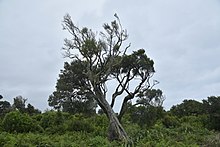| Dracophyllum arboreum | |
|---|---|

| |
| Scientific classification | |
| Kingdom: | Plantae |
| Clade: | Tracheophytes |
| Clade: | Angiosperms |
| Clade: | Eudicots |
| Clade: | Asterids |
| Order: | Ericales |
| Family: | Ericaceae |
| Genus: | Dracophyllum |
| Species: | D. arboreum
|
| Binomial name | |
| Dracophyllum arboreum | |
| Synonyms[2] | |
Dracophyllum arboreum, commonly known as Chatham Island grass tree and tarahinau (Moriori), is a species of tree in the heath family Ericaceae. Endemic to the Chatham Islands of New Zealand, it reaches a height of 18 m (60 ft) and has leaves that differ between the juvenile and adult forms.
D. arboreum has wide light green leaves in its juvenile form, which become thin needles as it gains maturity. Flowering occurs from November through to February, yielding small white flowers which later become tiny brown fruit. It inhabits many different types of vegetation communities from near sea level to 270 m (886 ft), including swamps, cliffs, bogs, and shrublands. It has a range restricted to three Islands some 800 km (497 mi) east of New Zealand: the Chatham, Pitt, and Rangatira Islands.
It was first described by the British botanist Joseph Hooker in 1864 as a variety of the species D. latifolium, but was first given the status as a species itself in 1902 by the New Zealand botanist Leonard Cockayne. Another New Zealand botanist, Thomas Cheeseman, demoted it once again to a variety in 1925, this time of D. scoparium, but this change has not been recognised by other botanists and institutions. The New Zealand naturalist Walter Oliver placed it in the subgenus Oreothamnus in 1928. A cladistic analysis in 2010 revealed through genetic sequencing that it was part of a paraphyletic group and not directly related to D. patens, as Oliver had suggested in his 1952 supplement, but to D. scoparium, as he had originally thought.
- ^ "Assessment Details for Dracophyllum arboreum Cockayne". New Zealand Threat Classification System (NZTCS) Department of Conservation (New Zealand). 2017. Archived from the original on 2021-04-22. Retrieved 4 August 2021.
- ^ Cite error: The named reference
:0was invoked but never defined (see the help page).
